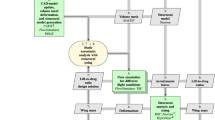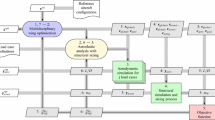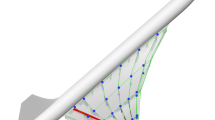Abstract
This article presents the development and application of a high-fidelity simulation process chain for commercial aircraft wing multidisciplinary optimization. Based upon a parametric CAD model the aerodynamic coefficients of the wing are determined through solving the Reynolds-averaged Navier–Stokes equations within a numerical flow simulation. Structural mass and elastic characteristics of the wing are determined from structural sizing of the wing box for essential load cases by usage of the finite element method. The interactions between the aerodynamic forces and the structural deformation of the elastic wing are taken into account in the process chain by fluid-structure coupling. To reduce the number of design variables, the design task is solved by a two-step approach. To design the inner wing, an optimization of the inner airfoil geometry and the wing twist with the lift-to-drag ratio as objective function has been conducted in the first step. Based on the inboard airfoil of this optimized inner wing, multidisciplinary optimizations of the wing planform have been performed in the second step. These optimizations include the wing twist and thickness distribution in span direction as design parameters but maintain airfoil shapes. A deterministic optimization method has been applied to locate the optimum within the design space. Range and efficiency, in terms of fuel consumption per range and payload, were used as objective functions in the wing planform multidisciplinary optimizations. Two approaches for the determination of the aerodynamic loads for the 2.5-g maneuver load case based on the aerodynamic loads under cruise flight conditions have been investigated. Both approaches have been integrated in the process chain for multidisciplinary wing optimization and have been used for the wing optimization of a long-range aircraft with backward swept wings. The results of the corresponding wing optimizations have been compared with each other.























Similar content being viewed by others
Abbreviations
- \(A\) :
-
Aspect ratio
- \(b\) :
-
Span
- \(C_\mathrm{L}\) :
-
Lift coefficient
- \(C_\mathrm{l}\) :
-
Local lift coefficient
- \(C_\mathrm{D}\) :
-
Drag coefficient
- \(C_\mathrm{D,res}\) :
-
Residual drag coefficient
- \(C_\mathrm{D,W}\) :
-
Drag coefficient wing
- \(c\) :
-
Chord length
- \(c_\mathrm{p}\) :
-
Pressure coefficient
- \({c_\mathrm{p}}_\mathrm{crit}\) :
-
Critical pressure coefficient
- \(g\) :
-
Acceleration of gravity
- \(H\) :
-
Altitude
- \(L/D\) :
-
Lift-to-drag ratio
- \(\mathrm{Ma}\) :
-
Cruise Mach number (\(\mathrm{Ma}=\frac{V}{a}\))
- \(m_{i}\) :
-
Aircraft mass at flight mission segment \(i\)
- \(m_\mathrm{Res}\) :
-
Residual mass
- \(m_\mathrm{MTO}\) :
-
Maximum take-off mass
- \(m_\mathrm{F}\) :
-
Fuel mass
- \(m_\mathrm{F,res}\) :
-
Reserve fuel mass
- \(m_\mathrm{P}\) :
-
Payload
- \(m_\mathrm{W}\) :
-
Wing mass
- \(n\) :
-
Load factor (\(n=L/W\))
- \(n_\mathrm{cpl}\) :
-
Number of fluid-structure coupling step
- \(n_\mathrm{fct}\) :
-
Number of optimization iteration
- \(R\) :
-
Range
- \(\mathrm{Re}\) :
-
Reynolds number (\(\mathrm{Re}=\frac{V\,l}{\nu }\))
- \(S\) :
-
Wing area
- \(\mathrm{SFC}\) :
-
Specific fuel consumption
- \(t/c\) :
-
Relative airfoil thickness
- \(u^{+}\) :
-
Dimensionless shear velocity
- \(V\) :
-
Flight speed
- \(y^{+}\) :
-
Dimensionless wall distance
- \(z_\mathrm{t}\) :
-
Wing tip deflection
- \(\varepsilon\) :
-
Wing twist
- \(\varepsilon _{jig}\) :
-
Wing twist for the jig shape
- \(\gamma\) :
-
Dimensionless local lift (\(\gamma =\frac{C_{l}\,c}{2b}\))
- \(\eta\) :
-
Dimensionless span coordinate (\(\eta =\frac{2y}{b}\))
- \(\eta _\mathrm{col}\) :
-
Dimensionless span of center of lift
- \(\lambda\) :
-
Taper ratio
- \(\varphi _\mathrm{LE}\) :
-
Leading edge sweep angle
- CAD:
-
Computer-aided design
- CFD:
-
Computational fluid dynamics
- CS:
-
Certification specifications
- CSM:
-
Computational structural mechanics
- CST:
-
Class function/shape function transformation
- DLR:
-
German Aerospace Center
- FAR:
-
Federal aviation regulations
- MDO:
-
Multi-disciplinary optimization
References
European Commision: European Aeronautics: a vision for 2020. Office for Official Publications of the European Communities, Luxembourg, Belgium (2001)
European Commision: 2008 Addendum to the Strategic Research Agenda. http://www.acare4europe.com (2008)
European Commision: Flightpath 2050 Europe’s Vision for Aviation. Office for Official Publications of the European Communities, Luxembourg (2011)
Kroll, N., Rossow, C.-C., Schwamborn, D.: The MEGAFLOW-Project—numerical flow simulation for aircraft. Prog. Ind. Math.ECMI 2004, 3–33 (2005)
Kroll, N., Gauger, N., Brezillon, J., Becker, K., Schulz, V.: Ongoing Activities in Shape Optimization Within The German Project MEGADESIGN. In: ECCOMAS 2004 (2004)
Kroll, N., Gauger, N., Brezillon, J., Dwight, R., Fazzolari, A., Vollmer, D., Becker, K., Barnewitz, H., Schulz, V., Hazra, S.: Flow simulation and shape optimization for aircraft design. J. Comput. Appl. Math. 203(December), 397–411 (2005)
Kroll, N., Becker, K., Rieger, H., Thiele, F.: Ongoing Activities in Flow Simulation and Shape Optimization within the German Megadesign Project. In: ICAS 2006, 25th International Congress of the Aeronautical Sciences (2006)
Kroll, N., Becker, K., Rieger, H., Thiele, F.: MEGADESIGN and MegaOpt—German initiatives for aerodynamic simulation and optimization in aircraft design. Springer, Berlin, Heidelberg (2009)
Gauger, N.R.: Ongoing activities in shape optimization within the German project MEGADESIGN. In: EUCCO2004, Dresden (de), 29. Accessed 31 March 2004 (2004)
Kroll, N., Heinrich, R., Krueger, W., Nagel, B.: Fluid-structure coupling for aerodynamic analysis and design: a DLR perspective. In: 46th AIAA Aerospace Sciences Meeting and Exhibit. Reno, Nevada (2008)
Keye, S., Sitzmann, M., Brodersen, O., Heinrich, R.: Fluid-structure coupled loads analysis of DLR’s F6 wing-body configuration. In: 46th AIAA Aerospace Sciences Meeting (2008)
Keye, S.: Fluid-structure-coupled analysis of a transport aircraft and comparison to flight data. In: 39th AIAA Fluid Dynamics Conference (2009)
Keye, S., Rudnik, R.: Aero-elastic simulation of DLR’s F6 transport aircraft configuration and comparison to experimental data. In: 48th AIAA Aerospace Sciences Meeting (2009)
Guruswamy, G.P., Byun, C.: Fluid-structural interactions using Navier-Stokes flow equations coupled with shell finite element structures. In: 24th AIAA Fluid Dynamics Conference. Orlando, Florida (1993)
Byun, C., Guruswamy, G.P.: Wing-body seroelasticity using finite-difference fluid/finite-element structural equations on parallel computers. In: 35th AIAA/ASME/ASCE/AHS/ASC Structural, Structural Dynamics, and Materials Conference. Hilton Head, South Carolina (1994)
Girodroux-Lavigne, P.: Progress in steady/unsteady fluid-structure coupling with Navier-Stokes equations. In: IFASD 2005, Mnnchen, 28.06.-01.07.2005 (2005)
Sobieszczanski-Sobieski, J., Haftka, R.T.: Multidisciplinary aerospace design optimization: survey of recent developments. In: 34th AIAA Aerospace Sciences Meeting and Exhibit. Reno, Nevada (1996)
Giesing, J.P., Barthelemy, J.-F. M.: A summary of industry MDO applications and needs. In: 7th AIAA/USAF/NASA/ISSMO, Symposium on Multidisciplinary Analysis and Optimization. St. Louis, Missouri (1998)
Chattopadhyay, A., Pagaldipti, N.: A multidisciplinary optimization using semi-analytical sensitivity analysis procedure and multilevel decomposition. J. Comput. Math. Appl. 29(7), 55–66 (1995)
Baker, M.; Giesing, J.: A practical approach to MDO and its application to an HSCT aircraft. In: 1st AIAA Aircraft Engineering, Technology, and Operations Congress. Los Angeles, California (1995)
Yang, G., Chen, D., Cui, K.: Response surface technique for static aeroelastic optimization on a high-aspect-ratio wing. J. Aircraft 46(4), 1444–1450 (2009)
Barnewitz, H.: Flexible wing optimisation based on shapes and structures. In: MEGADESIGN and MegaOpt—German Initiatives for Aerodynamic Simulation and Optimization in Aircraft Design. Springer, Berlin,Heidelberg, pp. 287–305 (2009)
Piperni, P., Abdo, M., Kafyeke, F., Isikveren, A.T.: Preliminary aerostructural optimization of a large business Jet. J. Aircraft 44(5), 1422–1438 (2007)
Chiba, K., Oyama, A., Obayashi, S., Nakahashi, K., Morino, H.: Multidisciplinary design optimization and data mining for transonic regional-jet wing. J. Aircraft 44, 1100–1112 (2007)
Jameson, A.: Aerodynamic design via control theory. J. Sci. Comput. 3(3), 233–260 (1988)
Jameson, A.: Optimum aerodynamic design using CFD and control theory. In: 12th AIAA Computational Fluid Dynamics Conference. San Diego, California (1995)
Jameson, A., Leoviriyakit, K., Shankaran, S.: Multi-point aero-structural optimization of wings including planform variations. In: 45th Aerospace Sciences Meeting and Exhibit. Reno, Nevada (2007)
Martins, J.R.R.A., Alonso, J.J., Reuther, J.J.: High-fidelity aerostructural design optimization of a supersonic business jet. J. Aircraft 41(3), 523–530 (2004)
Fazzolari, A.: An aero-structure adjoint formulation for efficient multidisciplinary wing optimization. Technische UniversitSt Braunschweig, Diss, Carl-Friedrich-Gau-FakultSt fnr Mathematik und Informatik (2005)
Fazzolari, A., Gauger, N., Brezillon, J.: Efficient aerodynamic shape optimization in MDO context. J. Comput. Appl. Math. 203, 548–560 (2007)
Kenway, G.K.W., Martins, J.R.R.A.: Multi-point High-Fidelity Aerostructural Optimization of a Transport Aircraft Configuration. J. Aircraft 51, 144–160 (2014)
Kenway, G.K.W., Kennedy, G.J., Martins, J.R.R.A.: Scalable parallel approach for high-fidelity steady-state aeroelastic analysis and adjoint derivative computations. AIAA J. 52, 935–951 (2014)
Liem, R.P.; Kenway, G.K.W.; Martins, J.R.R.A.: Multi-point, multi-mission, high-fidelity aerostructural optimization of a long-range aircraft configuration. In: 14th AIAA/ISSMO Multidisciplinary Analysis and Optimization Conference. Indianapolis (2012)
Martins, J.R.R.A., Lambe, A.B.: Multidisciplinary design optimization: a survey of architectures. AIAA J. 51, 2049–2075 (2013)
Wild, J.: Numerische Optimierung von zweidimensionalen Hochauftriebskonfigurationen durch Lösung der Navier-Stokes-Gleichungen. Technische UniversitSt Braunschweig. Diss, Juni (2001)
Dassault Systems. http://www.3ds.com, MSrz (2012)
ANSYS®. http://www.ansys.com, MSrz (2012)
Kamakoti, R., Shyy, W.: Fluid-structure interaction for aeroelastic applications. Prog. Aerosp. Sci. 40(8), 535–558 (2005)
Lam, X.B., Kim, Y.S., Hoang, A.D., Park, C.W.: Coupled aerostructural design optimization using the Kriging model and integrated multiobjective optimization algorithm. J. Optim. Theory Appl. 142(3), 533–556 (2009)
Raymer, D.P.: Aircraft design: a conceptual approach, 3rd edn. American Institute of Aeronautics and Astronautics (1999)
Kulfan, B.M.; Bussoletti, J.E.: Fundamental parametric geometry representations for aircraft component shapes. In: 11th AIAA/ISSMO Multidisciplinary Analysis and Optimization Conference. Portsmouth, Virginia (2006)
Kulfan, B.M.: A universal parametric geometry representation method-“CST”. In: 45th AIAA Aerospace Sciences Meeting and Exhibit. Reno, Nevada (2007)
Kulfan, B.M.: The “CST” universal parametric geometry representation method, Recent Extensions and Applications. In: Royal Aeronautical Society Conference. London (2007)
Sattler, S.: Vergleich und Bewertung von Parametrisierungsmethoden zur Optimierung von transsonischen Tragflngelprofilen., : Diplomarbeit. DLR Institut fnr Aerodynamik und Strömungstechnik, TU Braunschweig (2008)
Brodersen, O., Hepperle, M., Ronzheimer, A., Rossow, C.-C., Schöning, B.: The parametric grid generation system MegaCads. In: Soni, B.K., Thompson, J.F., HSuser, J., Eiseman, P. (eds.) 5th International Conference on Numerical Grid Generation in Computational Field Simulation National Science Foundation (NSF), pp. 353–362
Wunderlich, T.F.: MultidisziplinSre Optimierung von Flngeln fnr Verkehrsflugzeuge mit Berncksichtigung der statischen AeroelastizitSt. Technische UniversitSt Braunschweig. Diss, MSrz (2013)
Schlichting, H., Gersten, K.: Grenzschicht-Theorie, 10th edn. Springer, Berlin (2006)
Galle, M.: Ein Verfahren zur numerischen Simulation kompressibler, reibungsbehafteter Strömungen auf hybriden Netzen / DLR Institut fnr Aerodynamik und Strömungstechnik. Braunschweig, (DLR-Forschungsbericht 99–04). - Forschungsbericht (1999)
Gerhold, T.: Overview of the Hybrid RANS TAU-Code, In: Kroll N., Fassbender J. (eds.) MEGAFLOW—numerical flow simulation tool for transport aircraft design. Notes on multidisciplinary Design 89 (2005)
Schwamborn, D., Gerhold, T., Heinrich, R.: The DLR TAU-Code: Recent Applications in Research and Industry. European Conference on Computational Fluid Dynamics, ECCOMAS CFD, : Conference, p. 2006. The Netherlands, Delft (2006)
Kroll, N.; Fassbender, J.K.: MEGAFLOW - Numerical flow simulation for aircraft design, Braunschweig. In: Notes on numerical fluid mechanics and multidisciplinary design (NNFM) 89 (2002)
Kroll, N., Rossow, C.-C., Schwamborn, D., Becker, K., Heller, G.: MEGAFLOW—a numerical flow simulation tool for transport aircraft design. In: ICAS Congress 2002, S. 1.105.1-1.105.20. Toronto, Canada (2002)
Spalart, P.R., Allmaras, S.R.: A one-equation turbulence model for aerodynamic flows. In: 30th AIAA Aerospace Sciences Meeting and Exhibit (1992)
Nagel, B., Rose, M., Monner, H.P., Heinrich, R.: An alternative procedure for FE-Wing modelling. In: Deutscher Luft- und Raumfahrtkongress, Braunschweig (2006)
Nagel, B., Kintscher, M., Streit, T.: Active and passive structural measures for aeroelastic Winglet Design. In: ICAS Congress 2008, Anchorage, Alaska (2008)
Niu, M.C.-Y.: Airframe structural design. Conmilit Press Ltd., Hong Kong (1988)
Rudolph, P.K.C.: High-lift systems on commercial subsonic Airliners/National Aeronautics and Space Administration. (NASA Contractor Report 4746). - Forschungsbericht (1996)
Torenbeek, E.: Synthesis of subsonic airplane design. Delft University Press, Delft (1976)
Alcoa: aiscover aluminum again. Discover Alcoa’s Cost-effective and Proven New Technology. http://www.alcoa.com (2009)
Schwarmann, L.: Comparison of the strength and damage tolerance of aluminium alloys. Int. J. Fatigue 8(2), 73–77 (1986)
Industrie-Ausschuss Struktur Berechnungsunterlagen (IASB): Handbuch Struktur Berechnung (HSB), Luftfahrttechnisches Handbuch. Mnnchen: IABG mbH LTH-Koordinierungsstelle (1991)
Schwarmann, L., Nguyen-Hoang, V., Hilling, B.: Rechnerische AbschStzung des Schwingfestigkeitsverhaltens. In: Aluminium 65, Nr. 11, S. 1139–1145 (1989)
Heinrich, R.: Development and application of TAU-ANSYS coupling procedure. In: Kroll, N., Schwamborn, D., Becker, K., Rieger, H., Thiele, F. (eds.) MEGADESIGN and MegaOpt—German Initiatives for Aerodynamic Simulation and Optimization in Aircraft Design, Bd. 107, pp. 151–167. Springer, Berlin, Heidelberg (2009)
Beckert, A., Wendland, H.: Multivariate interpolation for fluid-structure-interaction problems using radial basis functions. Aerospace Sci. Tech. 5, 125–134 (2001)
Gerhold, T.: Efficient algorithms for mesh deformation. In: ODAS 2006–7th ONERA-DLR Aerospace Symposium. Toulouse, France (2006)
Wunderlich, T.F.: MultidisziplinSrer Entwurf und Optimierung von Flngeln fnr Verkehrsflugzeuge. In: Deutscher Luft- und Raumfahrtkongress, Aachen (DGLR-Tagungsband - AusgewShlte Manuskripte DLRK2009-1181) (2009)
Jacob, D.: Flugzeugbau II SS 2003. Skript zur Vorlesung. Lehrstuhl fnr Luft- und Raumfahrt, RWTH Aachen, Aachen (2003)
Wichmann, G., Strohmeyer, D., Streit, T.: Three-surface aircraft—a concept for future large aircraft. In: ICAS (Hrsg.): 22nd International Congress of Aeronautical Sciences. Harrogate, UK (1.1.R1) (2000)
Harris, C.D.: NASA supercritical airfoils: a matrix of family-related Airfoils/National Aeronautics and Space Administration (NASA). Langley Research Center. Technical Paper (1990)
Obert, E.: Aerodynamic design of transport aircraft. IOS Press BV, Amsterdam (2009)
Rowan, T.H.: Functional stability analysis of numerical algorithms, Department of Computer Sciences, University of Texas at Austin, USA, Diss., (1990)
Nelder, J.A., Mead, R.: A simplex method for function minimization. Comput. J. 7, 308–313 (1965)
Acknowledgments
The author wishes to thank the Institute of Aerodynamics and Flow Technology at the German Aerospace Center for providing the support of many colleagues and the computational resources for the complex computations. Furthermore, the author likes to acknowledge B. Nagel of the DLR Institute of Air Transportation Systems for his essential contribution with the tools PARA_MAM and S_BOT.
Author information
Authors and Affiliations
Corresponding author
Rights and permissions
About this article
Cite this article
Wunderlich, T.F. Multidisciplinary wing optimization of commercial aircraft with consideration of static aeroelasticity. CEAS Aeronaut J 6, 407–427 (2015). https://doi.org/10.1007/s13272-015-0151-6
Received:
Revised:
Accepted:
Published:
Issue Date:
DOI: https://doi.org/10.1007/s13272-015-0151-6




